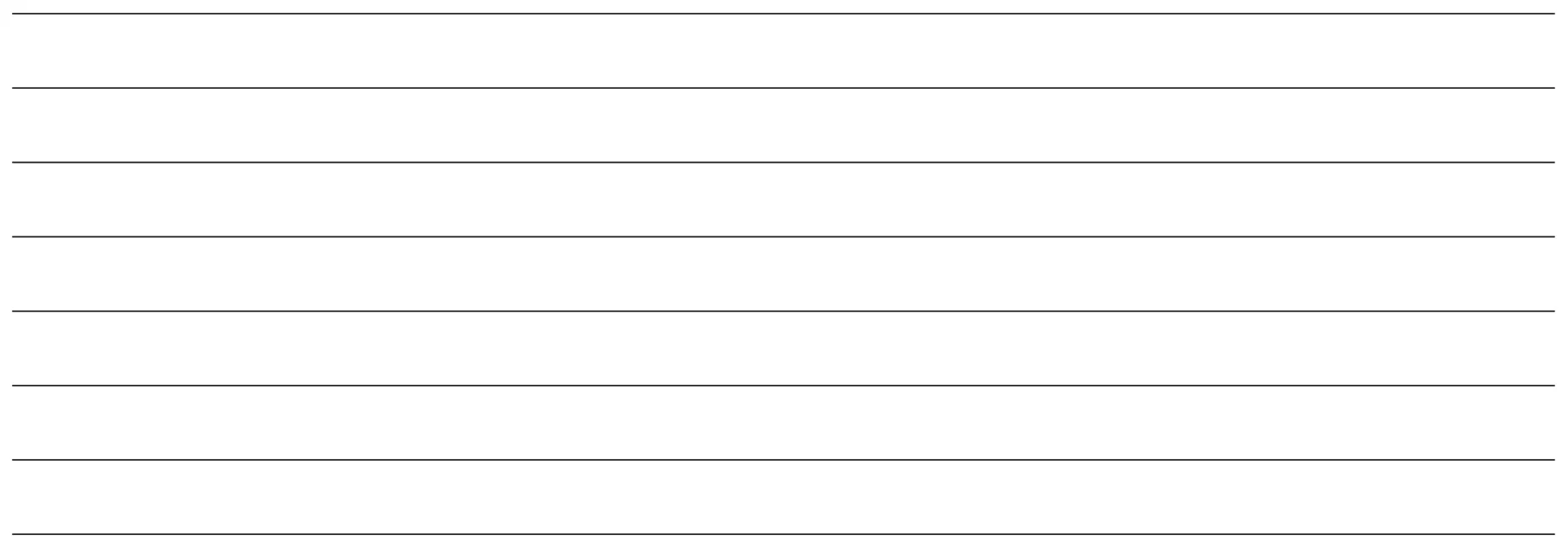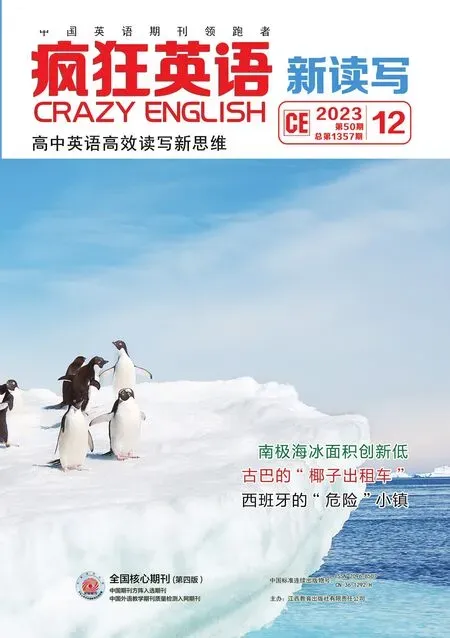走进科学,探索未来
本刊试题研究中心
第一部分 阅读(共两节,满分50分)
第一节 (共15小题;每小题2.5分,满分37.5分)
阅读下列短文,从每题所给的A、B、C、D四个选项中选出最佳选项。
A
If you could change your child's DNA in the future to protect them against diseases,would you? It could be possible because of technology known as CRISPR-C, or just CRISPR.
CRISPR involves a piece of RNA,a chemical messenger,designed to work on one part of DNA;it also uses an enzyme (酶)that can take unwanted genes out and put new ones in,according toThe Economist. There are other ways of editing DNA, but CRISPR will do it very simply,quickly,and exactly.
The uses of CRISPR could mean that cures are developed for everything from Alzheimer's disease to cancer to HIV. By allowing doctors to put just the right cancerkilling genes into a patient's immune system,the technology could help greatly.
The US National Academy of Sciences plans to discuss questions about CRISPR's ethics (伦理标准). For example, CRISPR doesn't work properly yet. As well as cutting the DNA it is looking for, it often cuts other DNA, too. In addition, we currently seem to have too little understanding of what qualities DNA gives people.
There are also moral questions around“playing God”. Of course, medicine already stops natural things from happening—for example, it saves people from infections. The opportunities to treat diseases make it hard to say we shouldn't keep going.
Also, according toThe Economist, gene editing may mean that parents make choices that are not obviously in the best interests of their children:“Deaf parents may prefer their children to be deaf too; parents might want to make their children more intelligent at all costs.”
In the end, more research is still needed to see what we can and can't do with CRISPR.“It's still a huge mystery how we work,”Craig Mello, a Medical School biologist and Nobel Prize winner, toldThe Boston Globe.“We're just trying to figure out this amazingly complicated thing we call life.”
1.What is the text mainly about?
A.What we can and can't do with CRISPR.
B.The advantages of CRISPR and arguments about its ethics.
C.How CRISPR was developed by scientists.
D.Scientists'experiments of using CRISPR to edit human embryos.
2.What does the author mean by saying“playing God”in paragraph 5?
A.Playing jokes on religious people.
B.Asking God to help deal with moral questions.
C.Following the instructions of God.
D.Doing things that go against nature.
3.According to the text,the technology of CRISPR________.
A.is very safe because it only cuts the DNA it is looking for
B.is very helpful to cure people of any disease
C.could cause parents to make unwise choices for their children
D.could help us understand how complicated life is
B
To solve the problem of tiny plastics polluting waterways, chemists in the Czech Republic are thinking small. Their brainchild is a new microrobot which is no bigger than the tip of a sharpened pencil. When sunlight hits the microrobots, they produce chemical reactions that push them through water in a specific direction. When they find a piece of plastic,they stick to it and start to break it down.
Chemist Martin Pumera at the University of Chemistry and Technology,Prague led the project. A decade ago, he chose to focus on the problem posed by microplastics. They're everywhere—from the bottom of the ocean to the air blowing onto ice atop mountains.They've turned up in drinking water.Some studies estimate that billions of pieces of plastic end up in the world's waters. The plastic has many sources, from shopping bags to washing and cleaning wipes.
In lab experiments, the star-shaped swimmers stuck onto each of four different types of plastic. And after a week exposed to light, the robots had reduced the weight of the plastics. It wasn't much—only by percent. But that was an indication that they were breaking the plastic down. They also caused the surface of the plastic to change from smooth to rough. That's another sign that the robots were degrading (分解) it. The new study is a proof of concept type.That means it shows something can be done successfully.
In fact,Pumera says they still have a long way to go.There are many types of plastics.And even these microrobots are unlikely to succeed in degrading them all. The researchers also have not yet shown how safe this system is for the environment, although Pumera says that's their next goal. The first real-world test will be in a wastewater-treatment plant.“Indeed,”says one researcher,“we'll need a lot of testing to show that they're safe in open waterways,such as at sea.”
4.What does the underlined word“brainchild”in paragraph 1 refer to?
A.Idea. B.Hope. C.Project. D.Routine.
5.What does the author focus on in paragraph 2?
A.The purpose of Pumera's project.
B.The preciousness of drinking water.
C.The seriousness of plastic pollution.
D.The working principle of the microrobots.
6.What shows the effectiveness of the microrobots in lab experiments?
A.The weight loss of the plastics.
B.The disappearance of the plastics.
C.The shape change of the microrobots.
D.The improvement in the quality of water.
7.Which of the following is a suitable title for the text?
A.Ways to obtain cleaner drinking water
B.Microrobots invented to treat wastewater
C.New hope for the solution to plastic pollution
D.Technology widely applied in environment protection
C
Over a four-year period, Swiss researchers have developed a machine that can keep human livers(肝)alive outside of the body for one week.
Livers are among the most commonly transplanted (移植) human organs. Current technology can only keep human livers alive for up to 24 hours.It is reported that,in 2017,about 8000 liver transplants were performed in the US,of which 360 used livers from living givers. In addition, about 11,500 people were registered on a waiting list to receive a liver transplant. Keeping livers alive and functioning for longer periods could greatly improve the chances of survival for patients.
The researchers say the purpose of their“Liver4Life”machine is to perform what they call liver perfusion (灌注) operations outside of the human body. Perfusion is the process by which blood or other liquids are pumped through organs and tissue. The machine keeps the liver at the right temperature and moves it in a way that would be natural in the body.Using a pump to fill the liver with blood acting like a human heart, the machine also provides oxygen to the organ,controls red blood cell levels and removes waste.
The research team began their experiments with livers from pigs. After repeated testing and engineering development, they succeeded in getting the pig livers to survive for seven days with support only provided from the Liver4Life machine. They also discovered the system can work to repair damaged livers. The team is now planning its next step to transplant machine-treated organs into patients.
Pierre-Alain Clavien, leader of the research said in a statement,“This technology will greatly increase the number of livers available for transplant, improving the chances of survival for patients. The success of this unique machine opens a way for many new applications in transplantation and cancer medicine.”8.What does the author intend to do in paragraph 2?
A.Introduce a brand new topic for discussion.
B.Provide some latest data about present liver transplants.
C.Show the urgency of tech improvement in liver transplants.
D.Remind readers of the importance of a healthy liver.
9.What does the underlined word“it”in paragraph 3 refer to?
A.The machine. B.The liver.
C.The temperature. D.The tissue.
10.What can we learn about the Liver4Life machine?
A.It is among the most commonly used machines for liver transplants.
B.It is aimed to carry out liver perfusion operations in the human body.
C.It can perform several functions to keep the liver working normally.
D.It can be used to keep the pig livers alive for more than one week.
11.Where is this text most likely from?
A.A biology textbook. B.A first-aid brochure.
C.A social web page. D.A health magazine.
D
Three scientists who studied how cells sense and adapt to oxygen levels have been awarded the Nobel Prize in Physiology or Medicine. William G. Kaelin, Jr. of the Dana-Farber Cancer Institute and Harvard University, Sir Peter J. Ratcliffe of Oxford University and the Francis Crick Institute, and Gregg L. Semenza of Johns Hopkins University were jointly awarded the prize.
“The meaningful discoveries by this year's Nobel winners showed life's most adaptive processes,”Randall Johnson, a member of the Nobel Assembly at Sweden's Karolinska Institute said.“The three physicians found the molecular switch (分子开关) that regulates how our cells adapt when oxygen levels drop.”
“Cells and tissues are constantly experiencing changes in oxygen availability,”Johnson said.“As an embryo (胚胎) grows and develops, and as muscles work, the oxygen available changes as the tissues themselves change. Cells need a way to adjust to the amount of oxygen they have,while still doing their important jobs.”
The committee said that the discoveries are vital for physiology and could exploit new strategies to fight anemia,cancer and many other diseases.
Kaelin was born in New York and received an MD from Duke University. He did his specialist training in internal medicine and oncology at Johns Hopkins, Baltimore, and at the Dana-Farber Cancer Institute,Boston.
Ratcliffe was born in Lancashire, the United Kingdom, and studied medicine at Gonville and Caius College at Cambridge University and did his specialist training in nephrology at Oxford.He is the director of clinical research at the Francis Crick Institute in London and a member of the Ludwig Institute for Cancer Research.
Semenza was born in New York. He obtained a BA in biology from Harvard and his MD from the University of Pennsylvania. He did his specialist training in pediatrics at Duke University.He is the director of the Vascular Research Program at the Johns Hopkins Institute for Cell Engineering.
12.What can we know about the three scientists?
A.They studied different fields.
B.They shared one prize.
C.They researched heart disease.
D.They found the function of embryos.
13.What did Johnson think of the discoveries?
A.Important. B.Meaningless.
C.Interesting. D.Disappointing.
14.What does the underlined word“exploit”in paragraph 4 mean?
A.Develop. B.Handle. C.Stress. D.Follow.
15.What do the last three paragraphs mainly talk about?
A.The three scientists'achievements.
B.The influence of the discoveries.
C.The example set by the three scientists.
D.The introduction of the three scientists.
第二节 (共5小题;每小题2.5分,满分12.5分)
阅读下面短文,从短文后的选项中选出可以填入空白处的最佳选项。选项中有两项为多余选项。
Virtually, there is nothing that man cannot do. Only what he has to do is keep doing and doing without being discouraged. Success will come someday or other, though it may apparently be the conception about something that it cannot be done.__16__But the reality is that man's success depends on whether he can do the toughest tasks successfully.It is because our life is complicated and tough. And to succeed in this tough battle,perseverance and hard work are a must.__17__We can prove this fact when we look at the reality of life and the history of man's success.Perseverance helps us do what we otherwise would consider impossible to do.
What the world-famous scientist Sir Isaac Newton had done by twelve years' constant hard work was burnt out by his pet dog. But that could not discourage him a little.__18___It is only for his undefeated perseverance that we have been able to have many inventions and discoveries.
__19___He went through thick and thin to reach his destination after months of the strenuous voyage on the sea. He discovered the way from Spain to America and offered the world a new route of communication with America. This outcome of his perseverance will be generated by the world forever.
All the great men in history have written their names in golden letters by means of perseverance.__20__If we all are perseverant in whatever we do, we are sure to stand out as a successful nation in the near future.
A.Every action has its reaction.
B.They are a unique precondition of success in life.
C.In human life,perseverance plays a very important role.
D.Their success will always remain as perfect examples to us.
E.Columbus has left us an adventurous story of perseverance.
F.The task that is easily done at the first attempt is undoubtedly very easy.
G.He was able to do it again through years of hard work and perseverance.
第二部分 语言运用(共两节,满分30分)
第一节 (共15小题;每小题1分,满分15分)
阅读下面短文,从每题所给的A、B、C、D 四个选项中选出可以填入空白处的最佳选项。
Rockets were probably invented by accident about 2000 years ago.The Chinese had a form of gunpowder which was put in bamboo tubes and thrown into fire to make__21___during festivals.Perhaps some of the tubes jumped out of the fire instead of exploding in it.The Chinese__22__that the gunpowder escaping from the tube could lift itself into the air.The idea of the rocket was__23__.
The first__24__use of rockets was in 1232. The Song Dynasty was at war with the Mongols.During the__25__of Kaifeng,the Song army__26__“arrows of flying fire”.The tubes were__27___to a long stick which helped keep the rocket moving in a straight direction.__28__the Mongols learned how to make rockets themselves and it is possible that they__29__them to Europe. Between the 13th and 15th centuries there were many rocket__30__in England, France and Italy. They were used for military purposes. One Italian scientist even invented a rocket which could travel over the surface of water and hit a(n)__31__ship.
Not everybody wanted to use rockets in battles. Wan Hu, a Chinese government official, invented a__32__chair. He attached two big kites to the chair, and 47 rockets to the kites. The rockets were lit. There was a huge explosion and__33__of thick smoke.When the smoke__34__, Wan Hu and his chair had disappeared. No one knows what happened.Did Wan Hu die in the explosion?Or was he carried miles into space,becoming the world's first__35__?
21.A.cuisines B.decorations C.explosions D.differences
22.A.thought B.discovered C.understood D.decided
23.A.born B.burst C.found D.improved
24.A.political B.formal C.military D.scientific
25.A.occupation B.attack C.search D.battle
26.A.lifted B.shot C.watched D.held
27.A.attached B.shaken C.wrapped D.used
28.A.Finally B.Suddenly C.Soon D.Thus
29.A.delivered B.threw C.passed D.introduced
30.A.transformations B.performances C.experiments D.exhibitions
31.A.business B.official C.transportation D.enemy
32.A.flying B.diving C.surfing D.blowing
33.A.packs B.clouds C.masses D.bunches
34.A.faded B.completed C.cleared D.reflected
35.A.chemist B.researcher C.astronaut D.explorer
第二节 (共10小题;每小题1.5分,满分15分)
阅读下面短文,在空白处填入1个适当的单词或括号内单词的正确形式。
Five outstanding researchers received L'Oréal-UNESCO For Women in Science International Award at a ceremony in Paris, France 36.______Friday evening for their pioneering research in the life science.One of the 37.______(receive)was Chinese ancient vertebrates(脊椎动物)scientist Zhang Miman.
87-year-old Zhang,also 38.______(know) as Meemann Chang,is a paleontologist (古生物学家) at the Institute of Vertebrate Paleontology and Paleoanthropology (IVPP). Many species, such as the extinct fish Meemannia, have been named in honor of her. In 2016,Zhang 39.______(give) the Romer-Simpson Lifetime Achievement Award, 40.______is the highest prize in vertebrate paleontology.
“She was appointed for her pioneering work on fossil (化石) records 41.______(lead)to a clear understanding of how aquatic (水生的) vertebrates adapted to life on land,”UNESCO said in a statement. Zhang was the 42.______(five) Chinese female scientist to win the award.The other four winners 43.______(be)from South Africa,the UK,Argentina and Canada.
As 44.______result of a partnership between French company L'Oréal and the United Nations Educational, Scientific and Cultural Organization, the L'Oréal-UNESCO For Women in Science foundation was founded in 1998 45.______(encourage) equality in science.Each winner will be awarded$100,000 as part of their prize.
第三部分 写作(共两节,满分40分)
第一节 (满分15分)
假定你是李华,你校英语报拟刊登一篇介绍中国科学家的短文,请你写一篇文章投稿。内容包括:
1.人物简介;
2.事迹或贡献;
3.对你的影响。
注意:
1.词数80左右;
2.可以适当增加细节,以使行文连贯。

第二节 (满分25分)
阅读下面材料,根据其内容和所给段落开头语续写两段,使之构成一篇完整的短文。
On a hot September afternoon, Peter and his friend Isabel were on their way to the library.When they passed by Tubman Park,Isabel suggested cutting through it to get to the library. As they entered the park, the sight of the swings (秋千) and the merry-go-round brought back a flood of memories of their childhood spent there.But now everything looked so old, sad, and dirty. Litter lay on the ground next to an overflowing trash bin. There were still young schoolchildren playing there but they had to avoid the trash that littered the playground. A little boy told them that the city took the other trash cans away and the remaining one never got emptied often.
As they headed towards the library, the two high school students wrinkled their forehead. In the library, they encountered Mrs Evans, their kind-hearted fifth-grade teacher, retired yet still passionate. Mrs Evans listened as Isabel and Peter eagerly explained what they'd seen. Finally, she recommended them to go to the City Hall to voice their concerns.
The next day, Isabel and Peter went into the building of the City Hall but met with an impatient officer.They were informed that the city couldn't help with their problem due to a tight budget.Discouraged,they left and turned to Mrs Evans for help.
Under her guidance, they decided to ask Go Green, a non-profit organization whose goal is to protect the environment, for help.“This group is good at raising money for projects just like yours,”said Mrs Evans. She promised to arrange them to present their ideas to Go Green.Hearing this,their face lit up.
Two main tasks remained ahead: researching ways to clean up the park and preparing a convincing presentation. As Isabel was good at researching while Peter always had a talent for speaking,they cooperated quite well.Isabel learned from a science magazine that a new type of trash bin can squeeze the trash down without being emptied often, which saves time, money, and energy. Based on this, Peter practiced his presentation over and over again.
注意:续写词数应为150左右。
Paragraph 1:
A week later, Peter stood nervously at the back of the hall where Go Green was meeting.

Paragraph 2:
After the meeting,Isabel excitedly told Peter the good news.


